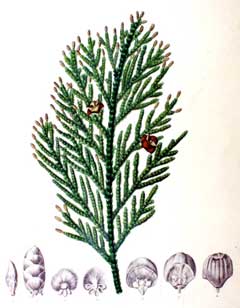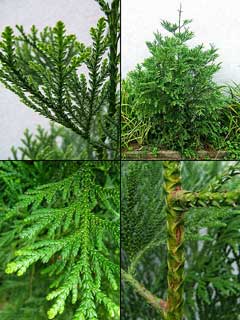 |
|
|
 |
| http://commons.wikimedia.org/wiki/User:Wildfeuer |
Translate this page:
Summary
UPDATE: This plant, Thujopsis dolabrata, was originally listed in the database as Thujopsis dolobrata. The name correct name was added 16/06/2011
Physical Characteristics

 Thujopsis dolabrata is an evergreen Tree growing to 20 m (65ft) by 10 m (32ft) at a slow rate.
Thujopsis dolabrata is an evergreen Tree growing to 20 m (65ft) by 10 m (32ft) at a slow rate.
See above for USDA hardiness. It is hardy to UK zone 5. It is in leaf all year, in flower from April to May, and the seeds ripen from September to October. The species is monoecious (individual flowers are either male or female, but both sexes can be found on the same plant) and is pollinated by Wind.
Suitable for: light (sandy), medium (loamy) and heavy (clay) soils. Suitable pH: mildly acid, neutral and basic (mildly alkaline) soils and can grow in very acid and very alkaline soils.
It can grow in semi-shade (light woodland) or no shade. It prefers moist soil.
UK Hardiness Map
US Hardiness Map
Synonyms
T. hondai. Thuja dolobrata. Thujopsis dolobrata
Plant Habitats
Edible Uses
References More on Edible Uses
Medicinal Uses
Plants For A Future can not take any responsibility for any adverse effects from the use of plants. Always seek advice from a professional before using a plant medicinally.
None known
References More on Medicinal Uses
The Bookshop: Edible Plant Books
Our Latest books on Perennial Plants For Food Forests and Permaculture Gardens in paperback or digital formats.

Edible Tropical Plants
Food Forest Plants for Hotter Conditions: 250+ Plants For Tropical Food Forests & Permaculture Gardens.
More

Edible Temperate Plants
Plants for Your Food Forest: 500 Plants for Temperate Food Forests & Permaculture Gardens.
More

More Books
PFAF have eight books available in paperback and digital formats. Browse the shop for more information.
Shop Now
Other Uses
The bark is used for match cord, for filling (caulking) between boards on boats etc to prevent water leaking[46, 61]. Wood - soft, durable, elastic. Used for construction, cabinet work, water pipes, ship building etc[46, 61].
Special Uses
References More on Other Uses
Cultivation details
Requires a moist sheltered site, preferably in or beside woodland[200]. Requires a high humidity but it is virtually unaffected by pH or winter temperatures[200]. A very slow growing plant in Britain[81], seedlings only grow about 3cm a year for the first 6 - 10 years and do not attain 30cm a year even when well established[185]. Unless shaded out by neighbouring trees, this plant retains its lower branches[81]. The sub-species T. dolobrata hondai. Mak. is a tall tree whilst T. dolobrata australis is a shrub or moderately sized tree[1].
References Carbon Farming Information and Carbon Sequestration Information
Temperature Converter
Type a value in the Celsius field to convert the value to Fahrenheit:
Fahrenheit:
The PFAF Bookshop
Plants For A Future have a number of books available in paperback and digital form. Book titles include Edible Plants, Edible Perennials, Edible Trees,Edible Shrubs, Woodland Gardening, and Temperate Food Forest Plants. Our new book is Food Forest Plants For Hotter Conditions (Tropical and Sub-Tropical).
Shop Now
Plant Propagation
Seed - best sown when ripe in the autumn in a cold frame[113]. Stored seed germinates best if given a short cold stratification[113]. It can be sown in a cold frame in late winter. When they are large enough to handle, prick the seedlings out into individual pots and grow them on in the greenhouse for at least their first winter. The plants make very little growth in their first year[78]. Plant them out into their permanent positions in late spring or early summer, after the last expected frosts. If growing large quantities of plants, the seed can be sown in an outdoor seed bed in mid spring[78]. Grow the plants on for two years and then plant them out into their permanent positions in late autumn or early spring. Cuttings of half-ripe wood, 5 - 8cm with a heel, July/August in a shaded frame. Forms roots by the end of September but it should be overwintered in a frame[78]. Cuttings of almost ripe wood.
Other Names
If available other names are mentioned here
Native Range
TEMPERATE ASIA: Japan (Hokkaidô, Honshu, Kyushu, Shikoku)
Weed Potential
Right plant wrong place. We are currently updating this section.
Please note that a plant may be invasive in one area but may not in your area so it's worth checking.
Conservation Status
IUCN Red List of Threatened Plants Status :

Growth: S = slow M = medium F = fast. Soil: L = light (sandy) M = medium H = heavy (clay). pH: A = acid N = neutral B = basic (alkaline). Shade: F = full shade S = semi-shade N = no shade. Moisture: D = dry M = Moist We = wet Wa = water.
Now available:
Food Forest Plants for Mediterranean Conditions
350+ Perennial Plants For Mediterranean and Drier Food Forests and Permaculture Gardens.
[Paperback and eBook]
This is the third in Plants For A Future's series of plant guides for food forests tailored to
specific climate zones. Following volumes on temperate and tropical ecosystems, this book focuses
on species suited to Mediterranean conditions—regions with hot, dry summers and cool, wet winters,
often facing the added challenge of climate change.
Read More
Expert comment
Author
(Thunb. ex L.f.)Siebold.&Zucc.
Botanical References
1158200
Links / References
For a list of references used on this page please go here
Readers comment
| Add a comment |
|
If you have important information about this plant that may help other users please add a comment or link below. Only comments or links that are felt to be directly relevant to a plant will be included. If you think a comment/link or information contained on this page is inaccurate or misleading we would welcome your feedback at [email protected]. If you have questions about a plant please use the Forum on this website as we do not have the resources to answer questions ourselves.
* Please note: the comments by website users are not necessarily those held by PFAF and may give misleading or inaccurate information.
To leave a comment please Register or login here All comments need to be approved so will not appear immediately.
|
Subject : Thujopsis dolabrata
|
|
|
|